The 10mm Auto is one of those cartridges with the capacity to capture the imagination like few others. Daydreams of charging feral pigs, scarcely trod trails, and pine-perfumed air are nearly inescapable when handling a 10mm. I fell under this spell years ago, and managed to break free for awhile…until the 10mm GP100 came along. The Centimeter GP was a pleasant surprise; I had given up hope of owning a duty-sized wheelgun in BESTmm. Handling and shooting this versatile revolver stokes a handgunner’s imagination like few other revolvers and suffice to say, I am a fan. This field report will explain why.
Reliability
The most important criteria in a handgun intended for any purpose other than pure entertainment is reliability. A hunting or defense sidearm must be reliable above all else. I tested the 10mm GP100 with over a dozen different loadings from over half a dozen manufacturers including Double Tap, Federal, Georgia Arms, Remington, Sig Sauer, Speer, and Underwood. These spanned the power spectrum from middling .40 S&W levels to rip-roarin’ 10mm stuff that would warm the heart (and hands) of The Colonel himself. I shot FMJs, JHPs, bare, hard-cast lead, and some other oddball stuff.
In total I fired somewhere north of 600 rounds through the gun with zero maintenance of any kind. When shooting 10mm ammunition I experienced not a single malfunction of any type, which is to mostly be expected with a new revolver. I assess this gun as extremely reliable with proper ammunition.
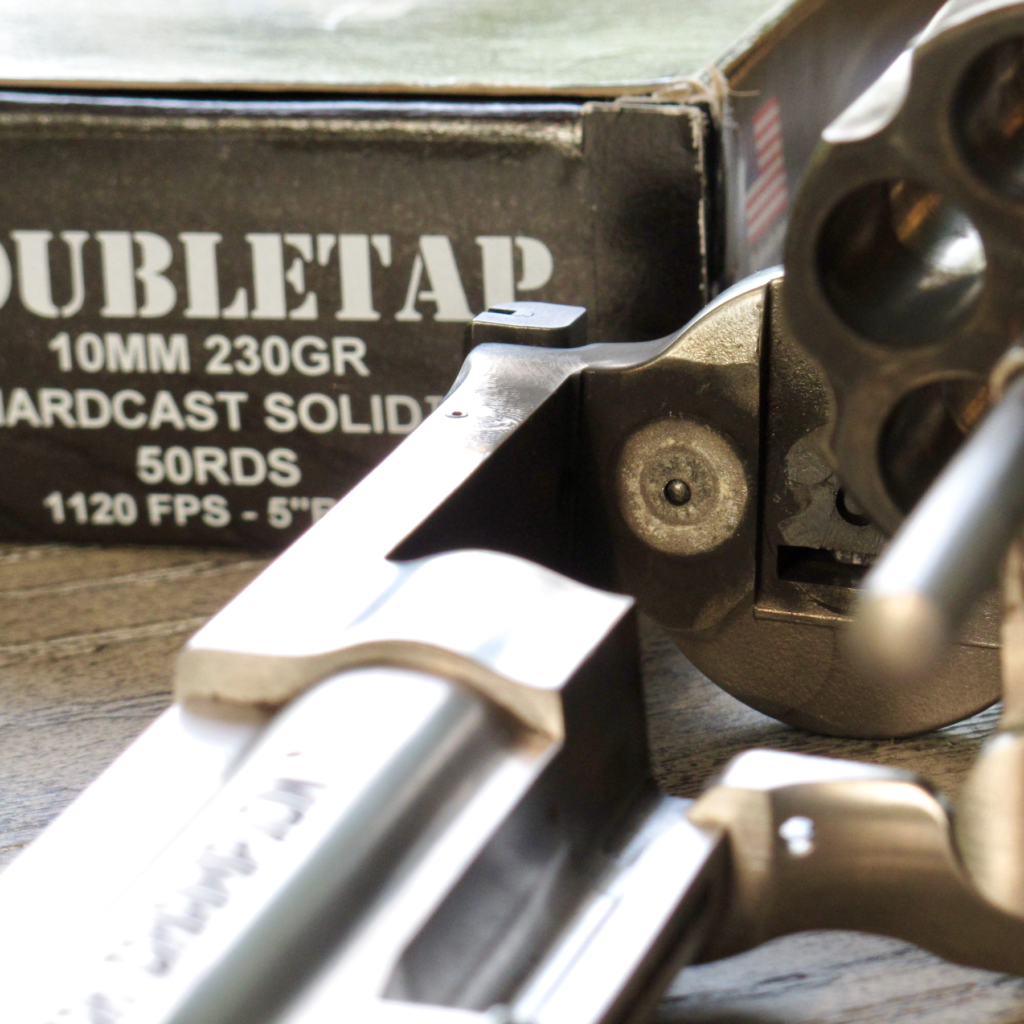
During my entire time with the 10mm GP100 I attempted to get .40 S&W cartridges to work reliably. As of now I have been unable to make this a reality. Thanks to Tom at TK Custom we are almost there, but not quite. My thoughts on the matter are this: shooting the .40 S&W in this gun is neat, and makes it a bit more flexible. However, this handgun is designated as “10MM AUTO” and NOT a “10mm/.40S&W” as some articles claim. If we can make .40 S&W work in it, that’s cool, but you probably shouldn’t purchase one with the primary goal of shooting a cartridge for which it isn’t intended, much like you shouldn’t buy a 9mm in hopes of shooting .380 ACP.
10mm Velocity
The 10mm is renowned for its velocity potential. One thing I (and surely others) was curious about was velocity from the GP100’s 4.2″ barrel. In addition to wearing a (theoretically) shorter barrel than many autoloaders, the GP100 also has the infamous cylinder gap (and quite a bit of free-bore) that one naturally assumes robs a bit of velocity. Further complicating matters, manufacturers’ advertised velocities are just that: advertised. There is often a difference between “advertised” and “actual.” With that in mind I decided to test the 10mm GP100 alongside a more traditional platform for the 10mm cartridge: a SR1911 in 10mm that Ruger was also kind enough to loan us.
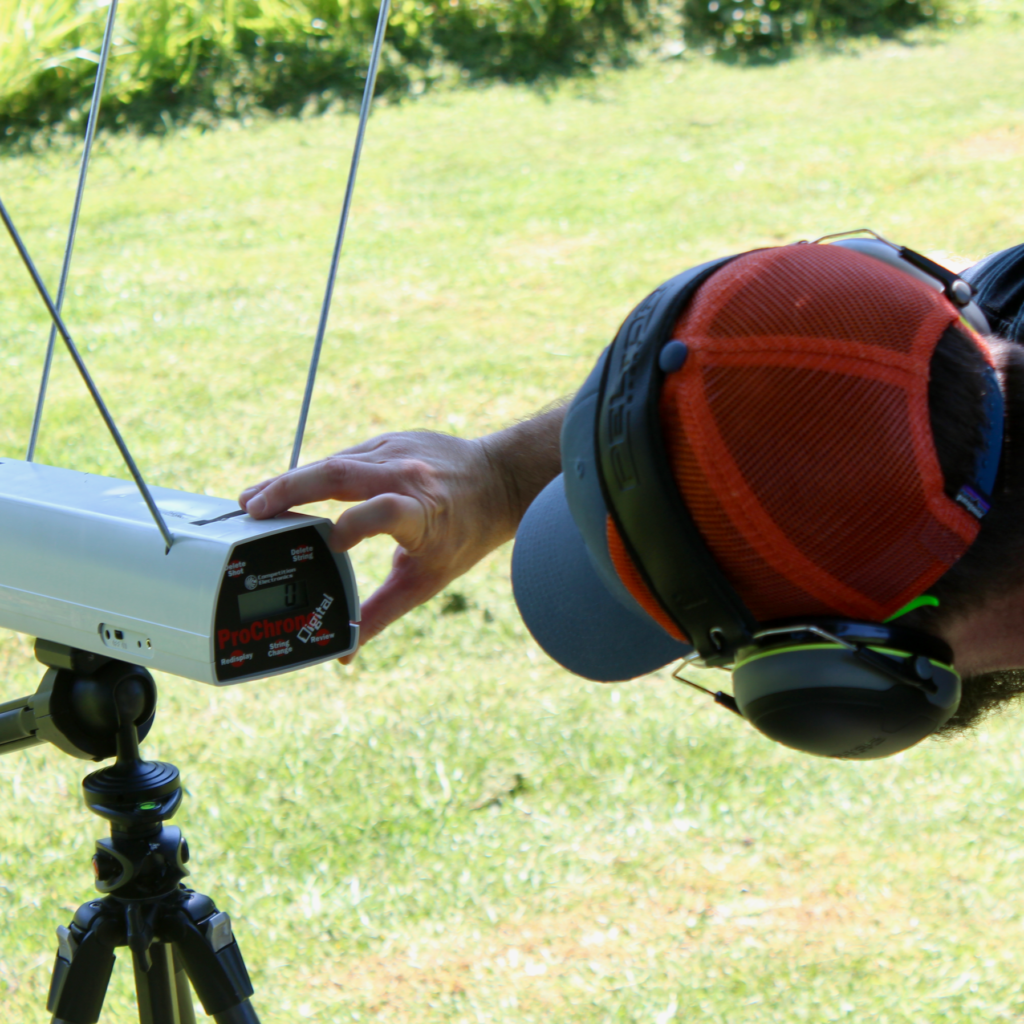
I loaded up seven different rounds from four different manufacturers and headed to the range. I was somewhat surprised at two findings. First, every single loading tested clocked in below advertised velocities, and sometimes well below. This was not unique to one gun or the other – in both platforms all ammunition tested failed to reach advertised velocities. Secondly, the difference between the revolver and the 5″ semi-auto weren’t as great as I would have imagined. The revolver held its own, staying neck-and-neck with the longer automatic. In one case the revolver even bested the 1911 in the velocity department.
The velocities listed in the chart below are an average of five shots.
| Load | SR1911 | GP100 |
Difference |
| Underwood 100-gr Xtreme Defender | 1778 | 1769 | -9 FPS |
| Sig 180-gr. V-Crown JHP | 1192 | 1171 | -21 FPS |
| Sig 180-gr. FMJ | 1198 | 1192 | -6 FPS |
| GA Arms 180-gr. Bonded Defense | 1153 | 1120 | -33 FPS |
| DT 200-gr Controlled Expansion | 1108 | 1111 | +3 FPS |
| Double Tap 200-gr. FMJ Match | 1079 | 1059 | -20 FPS |
| Double Tap 230-gr. WFNGC | 1085 | 1063 | -22 FPS |
| Average (Mean): | 1228 | 1212 | -15 FPS |
My takeaway from this is that one should worry less about the revolver’s cylinder gap, and more about the ammunition he or she is shooting. The Georgia Arms 180-grain load exhibited the biggest difference (33 FPS), but this was also the load with the biggest extreme spread (35 FPS in the SR1911, 40 FPS in the GP100). Even factoring that in, the mean velocity loss from the revolver was only 15 feet per second.
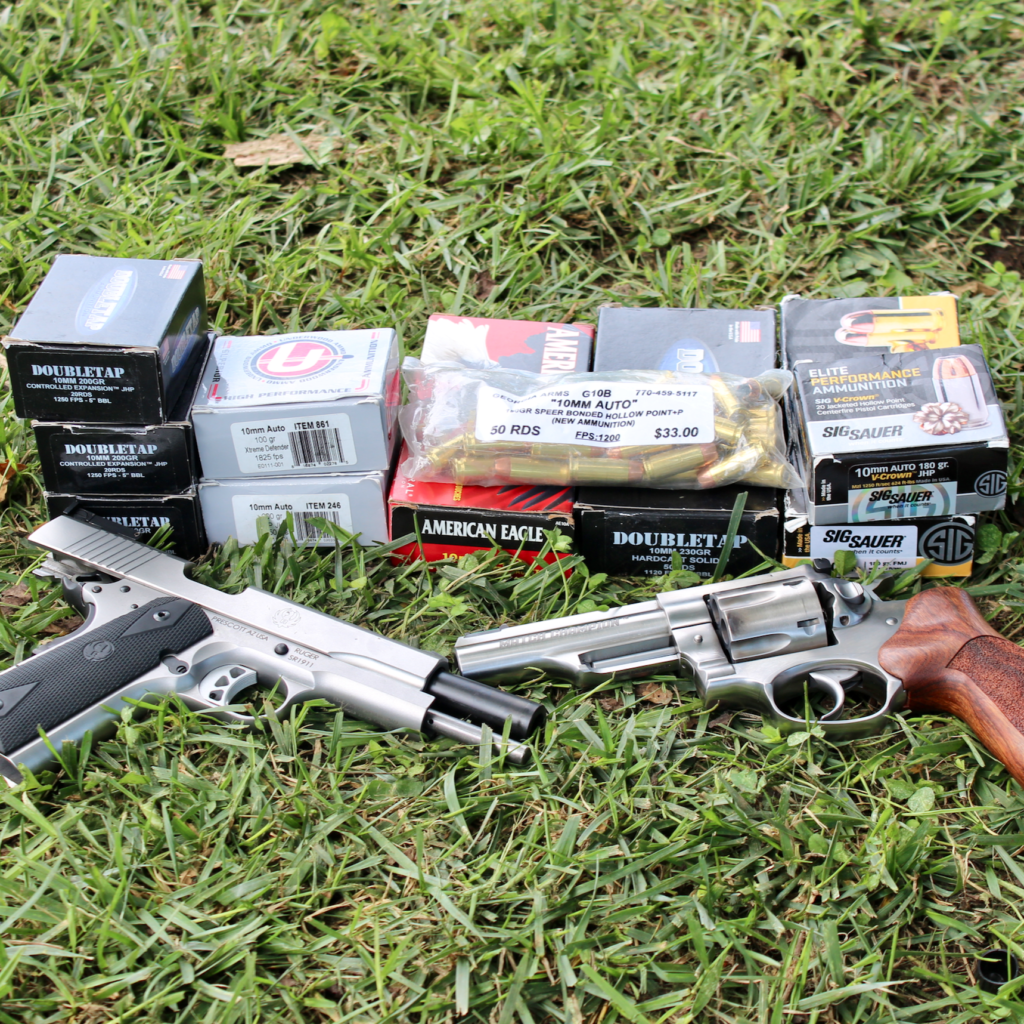
The bigger difference exhibited was the difference between manufacturer’s stated velocities and actual velocities. I’m not finger-pointing; testing velocity in a Glock may well result in better results than a traditionally-rifled barrel. The point is, don’t believe everything you read on a box or website. If you are relying on a certain load to meet an energy requirement, you should probably test the ammunition yourself.
There are quite a few factory 10mm loads I didn’t shoot. My velocity test conspicuously lacks anything in the intermediate weights (135- to 165-grain). Since the single Underwood load I tested was also the most consistent, I’d like to look at more of their offerings, as well. I plan to continue testing 10mm velocities in this revolver and may eventually run a more detailed article on the topic.
Recoil in the 10mm gp100
Of course there is no such thing as a free lunch, and for every action there is an equal and opposite reaction. Heavy bullets thrown at high velocities inevitably generate recoil. Recoil is also one of those “squishy” factors that is very difficult to quantify or explain with any measure of objectivity. Instead we’re limited to subjective words like “tolerable,” “stout,” or “punishing.” Sadly, this review will be little different in that regard, but I did find something interesting with the 10mm GP100.
In my initial review of this revolver I didn’t dwell on recoil because, to be honest, I didn’t notice it. I chalked this up to one of several things. It has been a while since I’ve owned a 10mm, so maybe I just forgot the nature of the recoil. Maybe I had grown more experienced and seasoned as a shooter in the interim, and recoil didn’t affect me as much. Or it could be the case that the 10mm’s recoil, like many other legends about the cartridge, had been greatly exaggerated. Turns out, none of these was the case. This became obvious when shooting the SR1911 with “real” 10mm ammo.
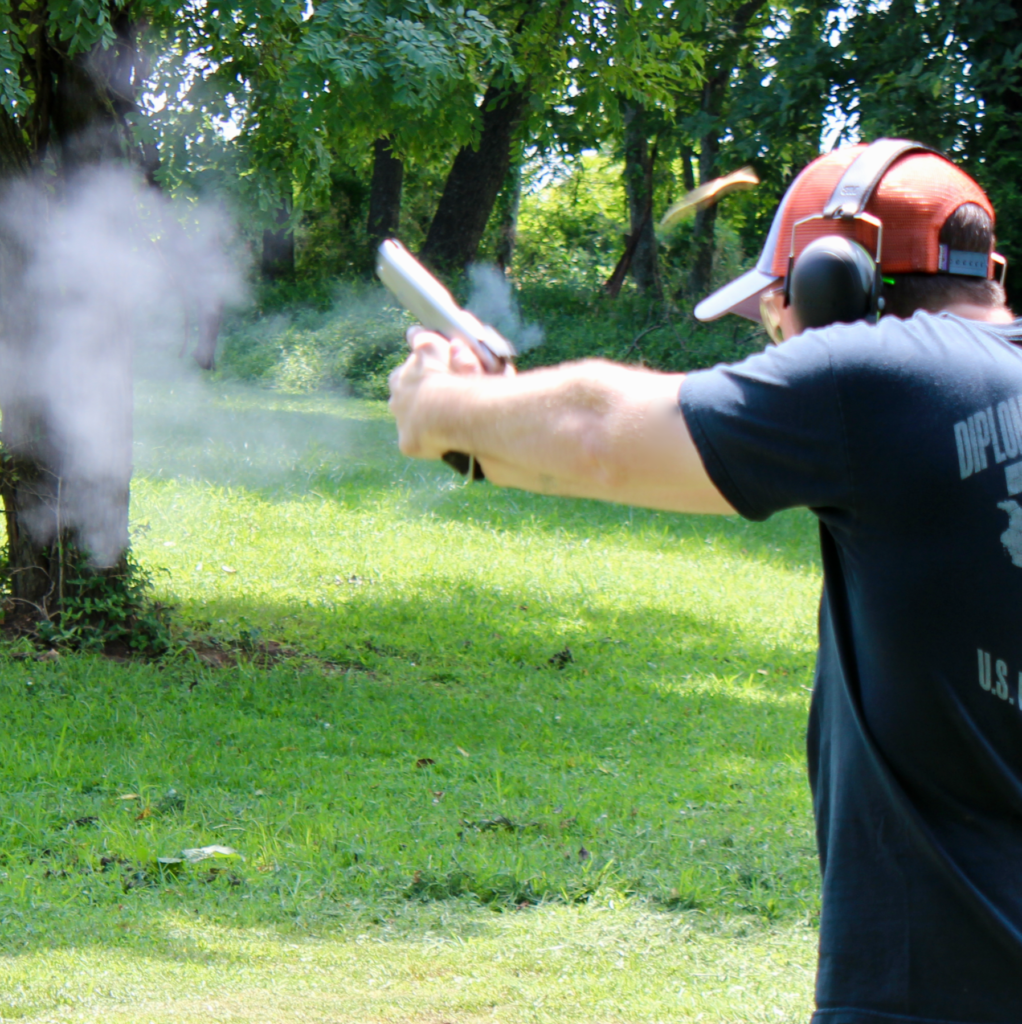
I had shot the GP100 with a wide array of ammo: low-powered, high-powered, fast, slow, light, and heavy. Some exhibited stronger recoil than others, but none were unpleasant in the slightest. Upon firing the first round of a magazine of 230-grain WFNGCs from Double Tap through the SR1911 I was taken aback. “So this is the unmanageable recoil they all talk about!” Firing the full magazine became a chore, as were a couple other loads, like Underwood’s 200-grain XTP. Despite being three ounces lighter than the SR1911 (37 ounces vs. 40 ounces) recoil in the 10mm GP100 is much tamer. This gun is an all-day-shooter with anything you care to load into it.
I’m not quite sure what to make of this, or to what to attribute it. Maybe it’s the unique shape and/or angle of the Match Champion’s grip? Perhaps the mass of the slide moving rearward at such high speed adds some additional energy to the SR1911s recoil cycle. It is possible that enough pressure is lost through the revolver’s cylinder gap that recoil is actually lessened, but the velocities recorded above would seem to contraindicate this theory. My pet theory is that maybe – just maybe – the “10MM AUTO” is a revolver cartridge that was switched at birth and should have been properly designated “10MM REVO”. . .
Accuracy
In my initial review of the 10mm GP100 I promised some bench-rested groups. I am going to let you down in this one because of three things. First, I find that I am neither terribly interested in, nor have the patience for, shooting from the bench. Secondly, while nitpicking such groups provided by other outlets is entertaining (I do it, too), it’s not how this gun will be used by me, or probably, by you. Finally, I found that I am not very good at generating minuscule groups from the bench. When shooting in single action from the bench my groups actually seemed to open up slightly, so that is a human problem I’m going to have to work on.
So instead, I tested the accuracy of the GP100 thusly: I fired a full cylinder of six shots from the offhand (standing) position, in double-action, at a distance of 25 yards. Each group was fired at a NRA 25-yard Slow Fire Pistol target. I believe the 5 5/16ths-inch black circle in this target as sufficiently small to represent a headshot on a human aggressor, or a humane, killing shot on medium/large game. I list the size of each group, as measured from center-to-center of the two most distant shots, in the captions.
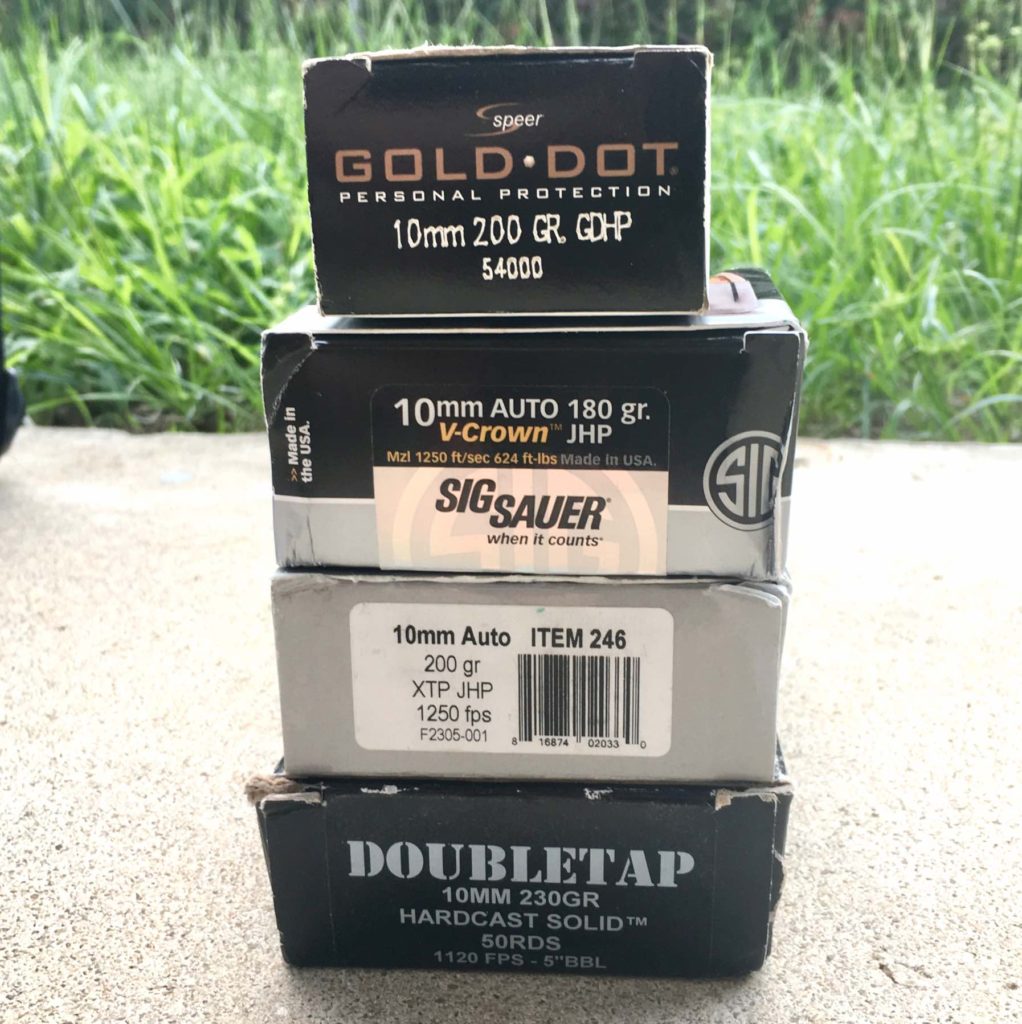
For this test I chose four loads from four manufacturers. Two of them represent excellent defensive cartridges for this caliber. They are premium, jacketed hollowpoints from well-known manufacturers: the new 200-grain Speer Gold Dot and the relatively new 180-grain Sig V-Crown. Both of these loads turned in respectable groups. Both also grouped slightly low because of sight regulation at the time of testing.
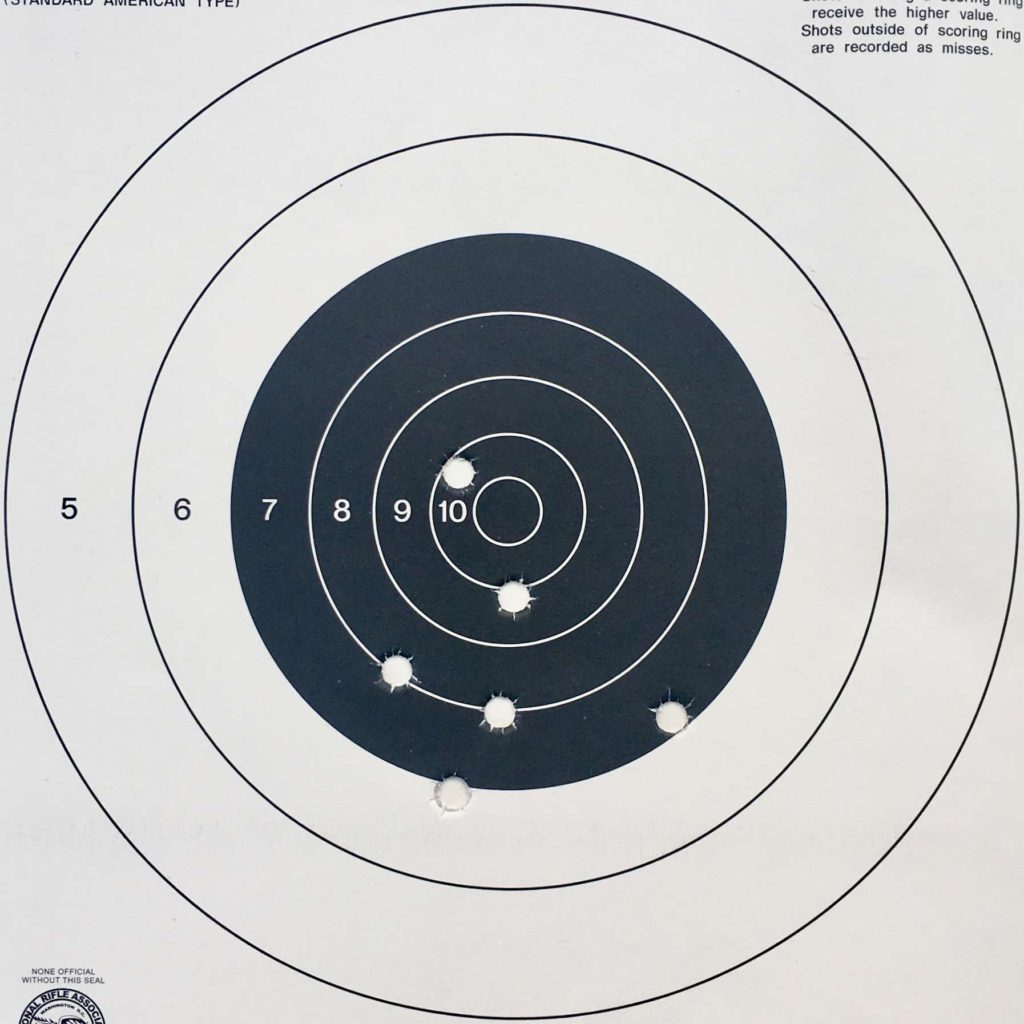
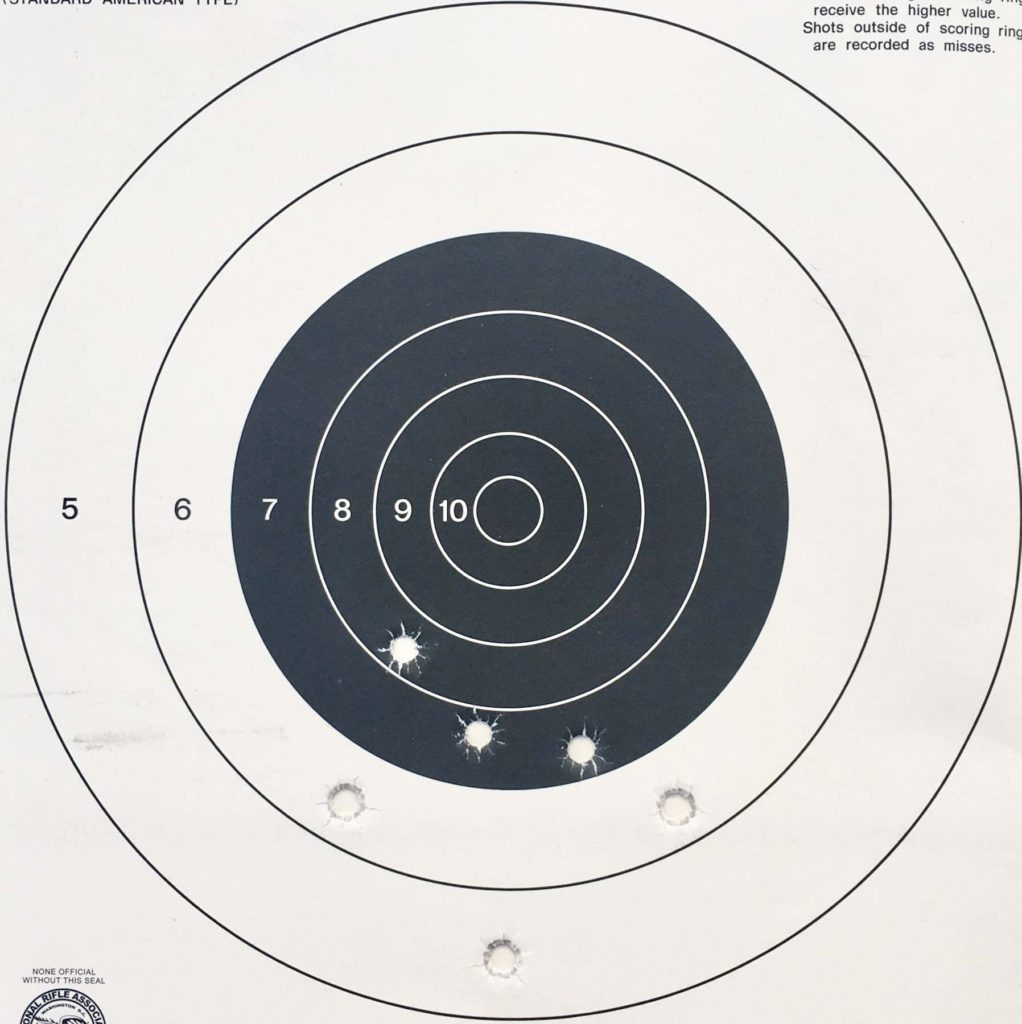
The other two represent potential outdoor loads more suited to hunting or predator defense, the other major use-category for the 10mm wheelgun: Underwood’s loading of the 200-grain Hornady XTP, and Double Tap Ammo’s 230-grain WFNGC hard cast bullet. Both of these printed closer to center, though groups opened up ever so slightly.
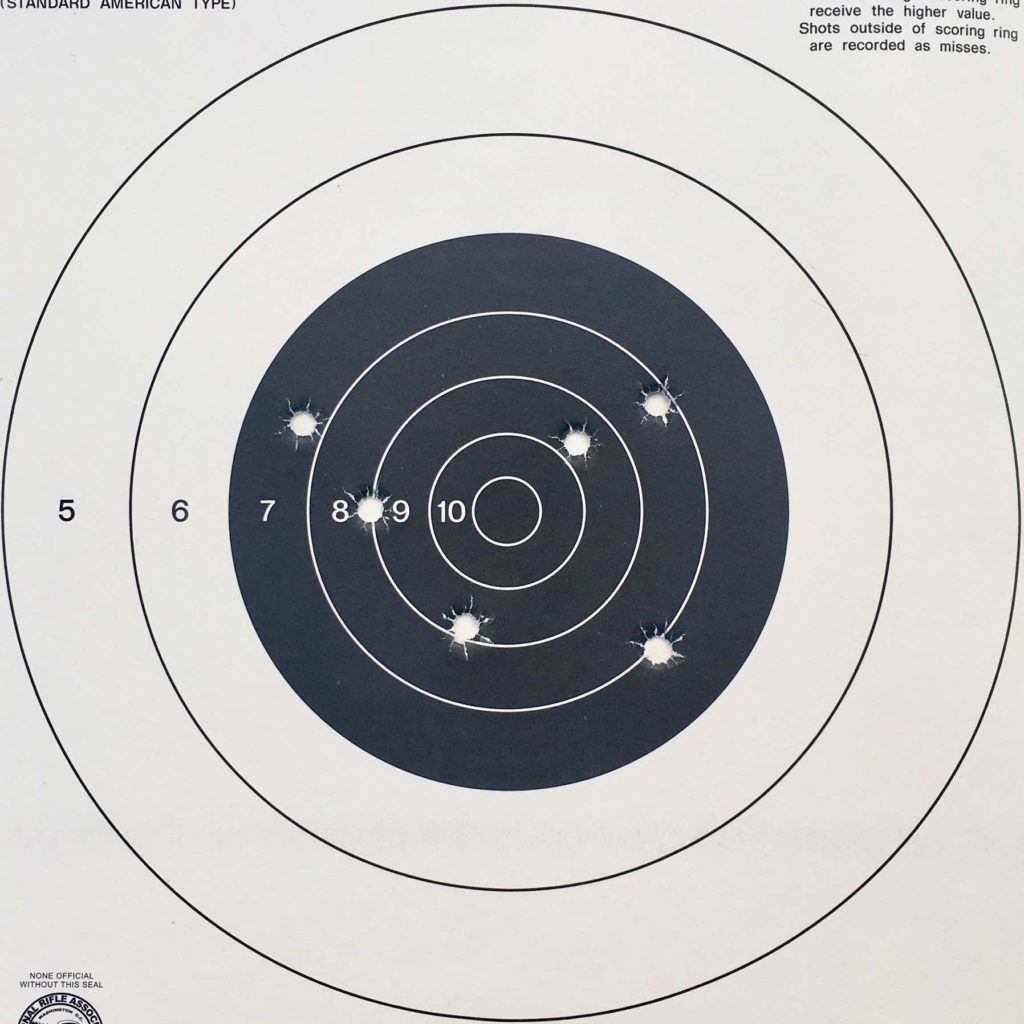
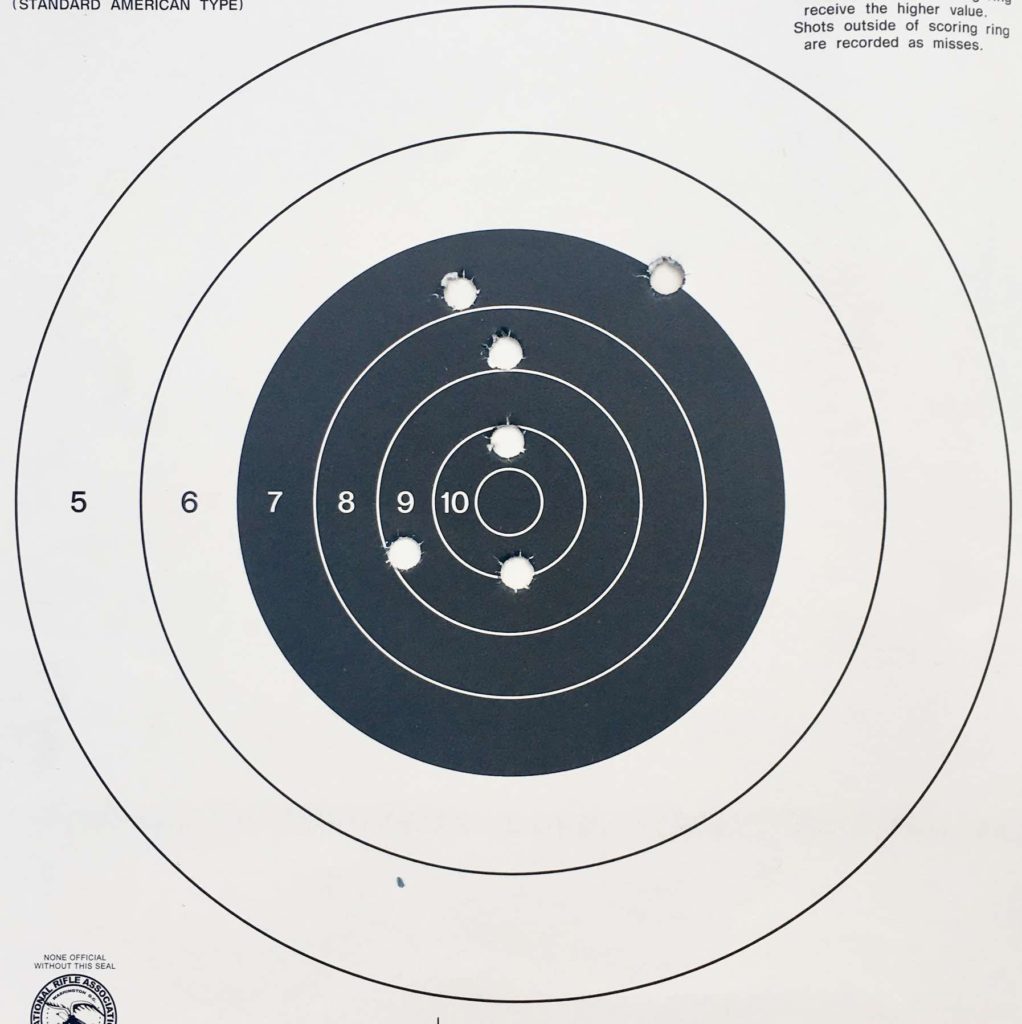
I’m sure my results here are nothing to write home about, especially in comparison with sub-2″ groups that are common to read about. But, they are honest, real-world-condition groups at a decent distance and I am satisfied with them.
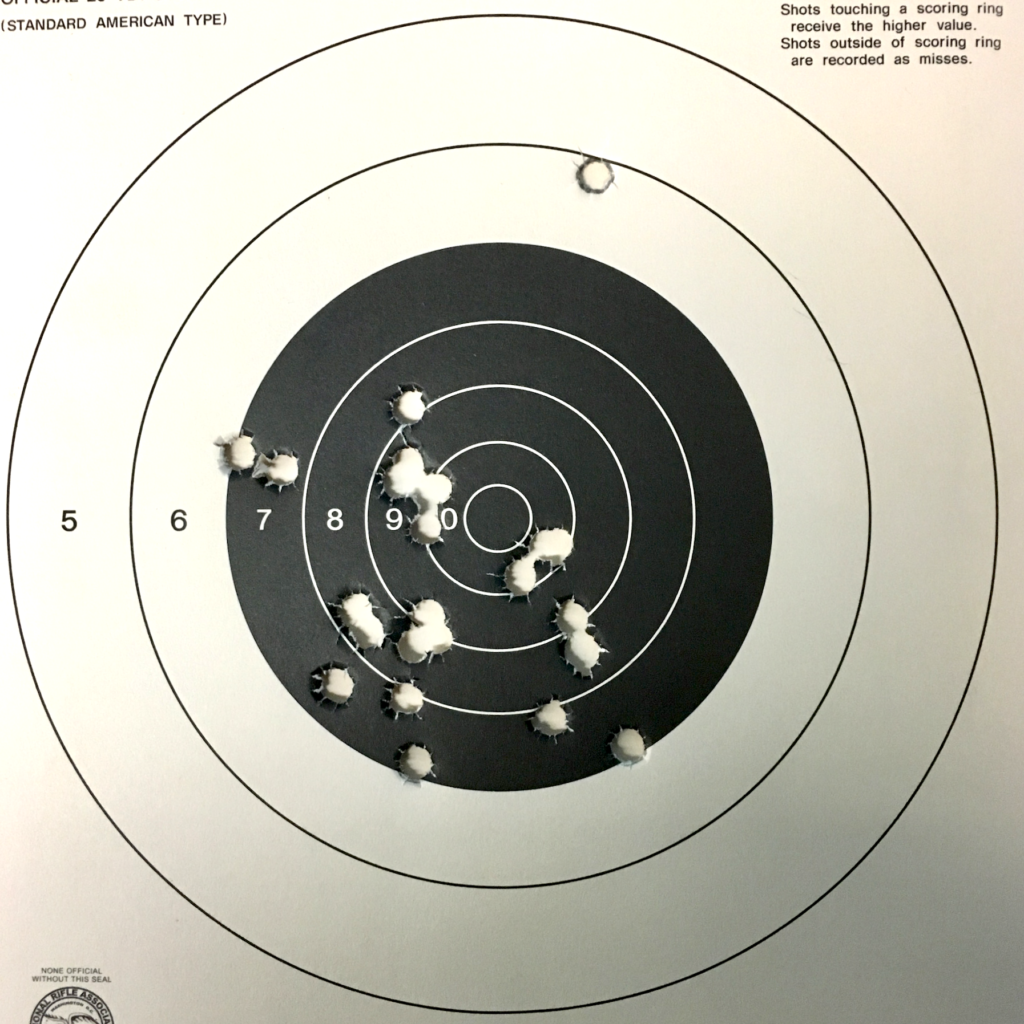
Of note, there is some POI shift depending on the load used. Mostly this isn’t too drastic, and it is probably possible to find suitable hunting and defensive loads that share a point of impact. The extremely light, fast 10mm bullets don’t abide this rule, however. The 100-grain Underwood load printed several inches below the POA that worked reasonably well for all other loads tested. I will test some loads in the future and get some better data on how severe the difference between POI is.
Odds ‘N Ends
One thing that bothered me about the .357 GP100 Match Champion was the propensity of the rear-sight pin to walk out. Losing the rear sight for want of a pin is a serious fail. The older friction-fit pin has been replaced with a roll pin in this variation of the GP100, and for the better. Through over 600 rounds (so far) of 10mm ammunition, the pin has kept itself firmly in place. I am extremely impressed with this development.
Speaking of sights, I also reached out to Hamilton Bowen to request a Rough Country Rear Sight for the 10mm GP100. Make no mistake: the OEM rear sights on the Ruger support excellent accuracy. However, as my new “for-all-reasons” revolver, I feel the GP100 could us a sight upgrade to the absolute best-in-class. Which leaves me with the front sight. I am at a loss for what to do with it. The fiber optic isn’t bad, and it’s certainly better than the version on the .357 Match Champion. But personal preference being what it is, I don’t like it. At some point I may have a gold-bead front manufactured for this revolver if I can’t find a suitable aftermarket production sight.
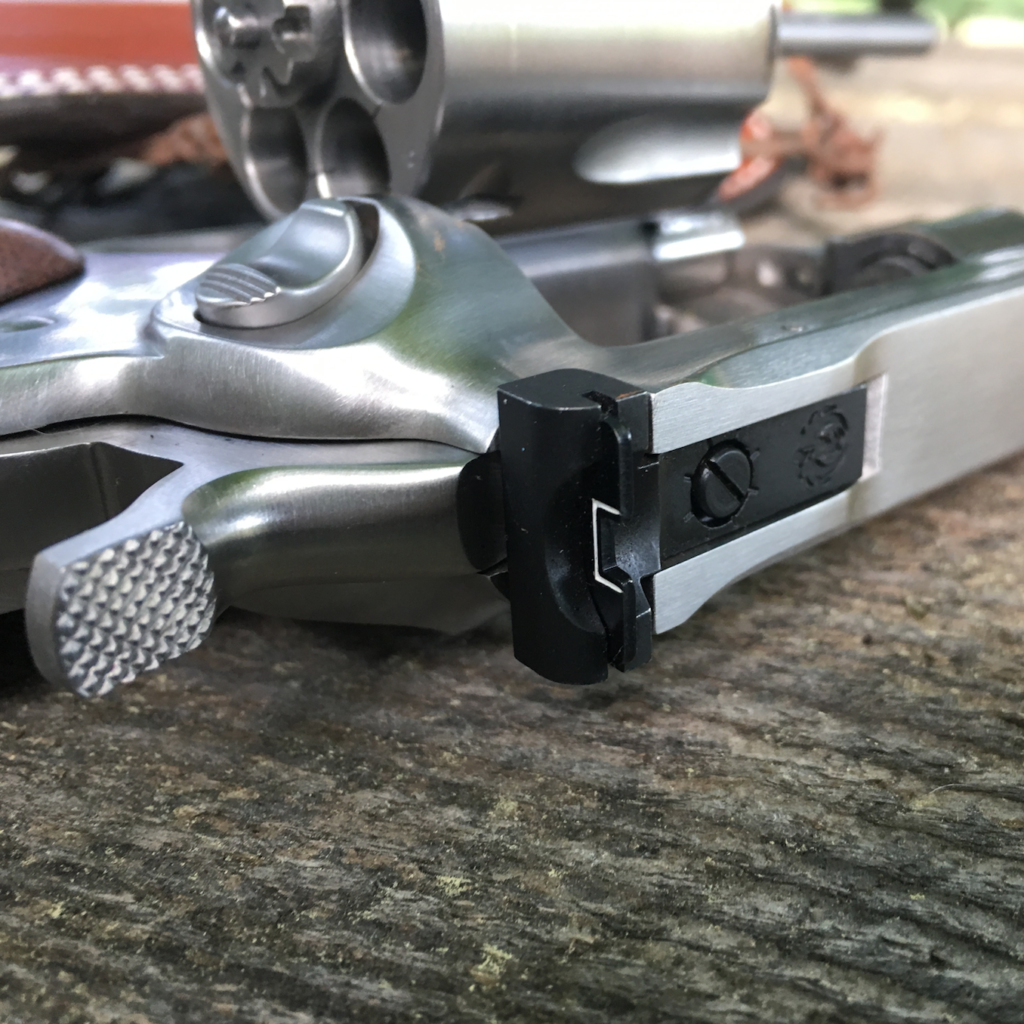
The provided moon clips from Ruger work well and will definitely get you started with this gun. They are easy to load and unload without tools, and support extraction of fired cases. However, I am sold on TK Custom clips. They hold the cartridges more securely and prevent the “drooping” that is common with the Ruger clips. They can’t be easily loaded by hand, but if you’re planning to shoot this gun a lot they are well worth the investment.
I also fired this gun quite a lot without moon clips to no ill effect. Since the cartridges headspace from the case mouth, moon clips aren’t strictly necessary. This is a nice touch as the loss, damage, or simple forgetting of moon clips doesn’t render your revolver inoperable. Because the cases sit so high in the cylinder, they are easily plucked out by hand. I also found a 10mm 1911 magazine to be an ideal cylinder loader. If one wanted to carry the 10mm GP100 for defense but not a spare moon clip, he or she could keep the rounds in the gun in a clip for fast ejection, and the spare rounds in a 1911 or Glock 20 magazine. This isn’t the fastest reload, but it’s far superior to reloading loose rounds.
My Ammunition Choices
Like me, but unlike some revolvers, this gun is a generalist. It will work pretty well for just about any purpose you’d expect from a duty-sized revolver. I essentially see the 10mm GP100 as ideally suited to three purposes: self-defense against human aggressors, animal defense, and hunting. My selection of ammunition reflects these varied use-cases. The intersection of recoil, accuracy, and terminal effectiveness will guide my personal choices for ammunition in the 10mm GP100.
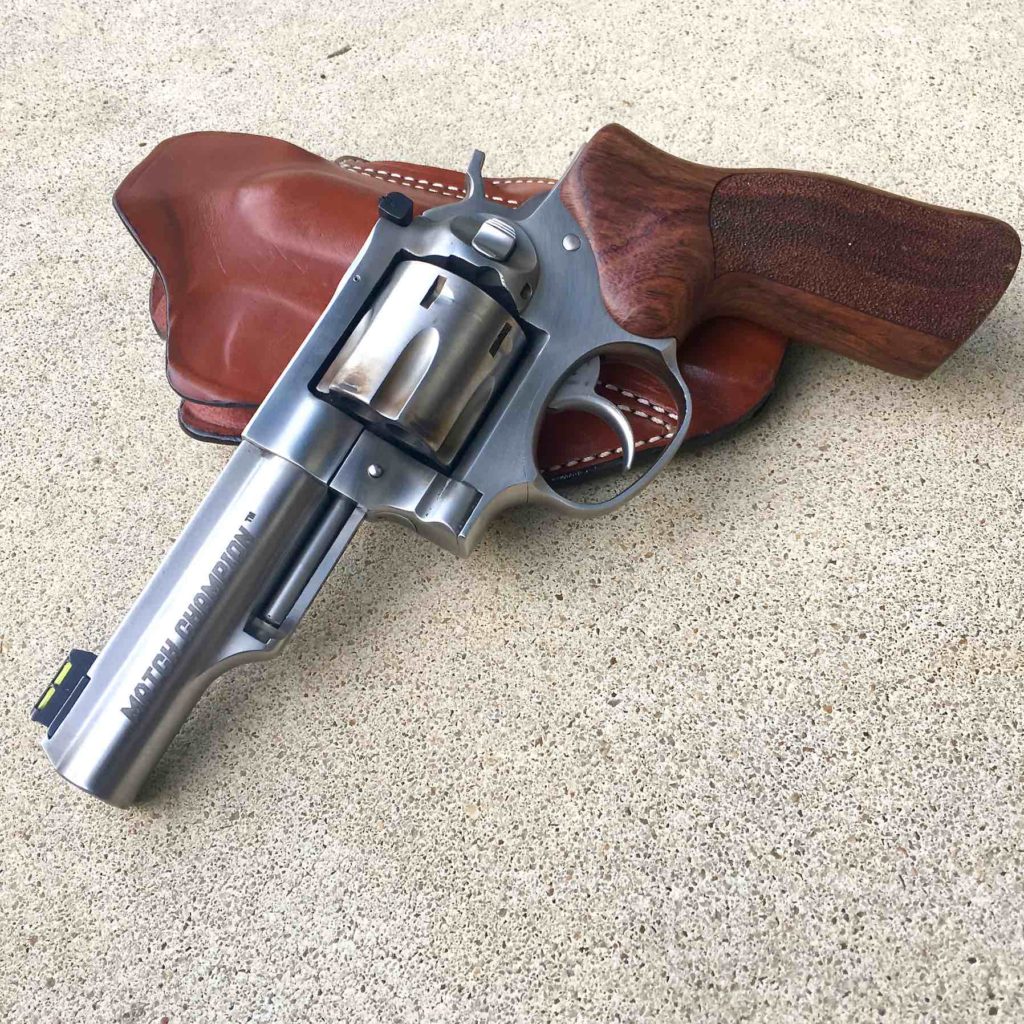
For personal defense purposes I currently have some Sig 180-grain V-Crown JHP and some of the brand new 200-grain Speer Gold Dot. Both of these mid-range rounds exhibit manageable recoil, decent accuracy, and performed extremely well in Lucky Gunner’s recent 10mm gel test. Both of these would also doubtlessly perform well on light game like whitetail, which I hope I have the chance to test this year. I tend to favor the Gold Dot. It’s slower velocity means its point of impact is likely closer to that of heavy loads, allowing me to regulate sights at a single point of impact or acceptable middle-distance.
For for predator defense, and should I ever dip my toe into heavy or dangerous game, I’ll stick with hard cast, wide flat nose bullet like those offered from Buffalo Bore, Double Tap, and Underwood. Further testing is required to determine which of these I prefer. Double Tap’s 230-grain load prints reasonably close to the Gold Dot’s point of impact, but I’m going to test a few more anyway. I would also love to find a practice load that shares a point-of-impact with the more “serious” ammo.
The Bottom line
I am smitten with this revolver – it is truly a dream come true. I would have been happy with just about ANY 10mm revolver, but the 10mm GP100 Match Champion is really something special. Expect to see this revolver on these pages a lot more in the coming months. I am still a huge fan of the .357 Magnum and the revolvers that chamber it. But. . . if you want something a little off the beaten track, something just a little different, and something that packs a lot more punch, the 10mm GP100 should be on your short list. This revolver is a shooter, a hunter, a defender, all in a duty-sized package. However. . .
There will be a Part III to this review. I thought I had written just about everything that needed to be written about this revolver until yesterday. I took the 10mm GP100 to the range and fired a final 100 rounds, and discovered a couple new things. Apparently this revolver hasn’t given me all of its secrets yet. I will write these up, along with some more velocity data, and some point-of-aim/point-of-impact information about the 10mm GP100. Stay tuned!

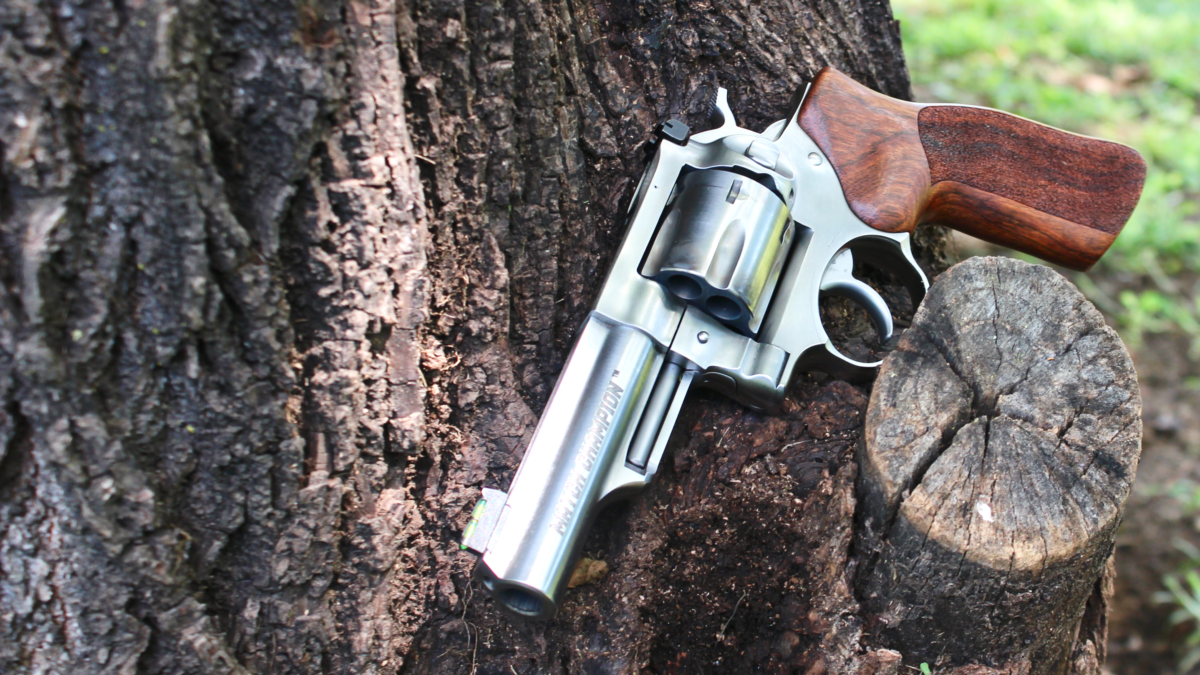
Great stuff, Justin, and excellent shooting! That looks like a super revolver.
The thing that impressed me most about your review? First article on a 10mm gun that I’ve ever read that doesn’t mention the FBI. Thank you!
Well, FBI was used, just not as would be done with your usual 3-letter alphabet agency.
The letters “F”, “B”, and “I” were scattered throughout using a 256 bit microtonic algorithmic encryption based off the Enigma cipher. ; )
( btw, what are those boats doing floating on the runway ??? )
Must be the Russians.
Great article, enjoyed it!
Thank you for all of the hard “work”!
Justin, et al
I have just acquired Ruger’s GP100 Wiley Clapp, 3″ barrel version. It is freakin’ beautiful. I have no desire to shoot 40sw in it. Primary purpose is defensive from both 2 and 4 legged creatures. Any recommendations as to ammo given the 1″ loss in barrel length?
Anthony,
I’m jealous of the 3″ GP! That looks like a really handy size. I asked for one, but unfortunately we can’t get TALO exlusive guns on T&E loan. I’d probably be happy with the Gold Dot or Sig V-Crown loads. However, being unable to ascertain velocity makes this a good guess at best. Modern JHPs are designed to expand within a certain velocity envelope. Too far below that and they don’t expand, behaving very much like FMJ.
Remember what Chuck Haggard said, though: “it all works pretty well if you can shoot. None of it works if you can’t shoot.” I would try out a few and favor the one(s) that you can shoot well.
Thanks for writing in!
Justin
Justin,
The 10mm Match Champion sounds intriguing and is a great looking revolver. I appreciate the good information and like that you did practical accuracy testing.
Seeing the ballistics of the 10mm is inspiring me to finish the load development for my 6” GP100 .357 before deer season. Currently working with 180 WFN and 165 Keith style hard cast.
Great article!
Thanks, Jim! I love modern JHPs but for the woods it’s hard to beat “old-school” projectiles like the WFN and Keith-style bullets. Let us know how what you decide on!
Nice right-up. I am really kind of surprised by the recoil difference between the SR1911 and the GP100. The general wisdom that I have read is that the slide movement spreads recoil force over a longer time frame, thus reducing the felt effect. I haven’t had a good chance to compare the same load in a semi-auto and revolver like you did, so I can’t say for certain, but it seemed logical. Apparently that is not always true.
I had read about using semi-auto mags for holding reloads, and I’ve even considered picking up a Coonan mag for my .357’s, but, for some reason, I didn’t think of doing that this a 10mm.
Ruger’s ‘santoprene’ grips do an excellent job at cushioning the hand against the recoil generated. They’re probably some of the best on the market.
I’ve had the opportunity to shoot the full house 240gr .44 Magnum out of both a Ruger Redhawk, and out of a Super Redhawk with the ‘GP100’ type grips. My perception was that the standard Redhawk delivered more recoil to my hand than did the Super Redhawk. Have shot the 10m/m out of a Glock, and it was definitely not to my liking. The photo of the 1911 platform in full recoil reminded me of the ‘ugh’ factor.
There are a few differences. The bore axis of the GP100 is higher than that of the 1911. This may direct recoil back in more of an arc, resulting in more muzzle flip but less “felt” recoil. The grip angle is somewhat similar to a 1911, but the grip itself is contoured and rounded. Also, there is no beavertail on this gun that presses into the web of the hand, which possible results in a more severe wrist angle.
No one was more suprised by this than me. After shooting the GP I assumed the 1911 would be a piece of cake, but boy was I wrong. Also keep in mind, this is somewhat subjective and anecdotal, but Military Arms Channel also seemed to think a 10mm 1911 has a bit more recoil than the GP100, if memory serves (incidentally I also think he’s one of the reviewers that said you could shoot .40 S&W in this gun). It’s an interesting phenomenon for sure, but I definitely won’t be working the SR1911 as hard as I worked this revolver!
I bought an older bone-stock GP100 .357 instead of a new one because of fears about Ruger’s quality control lately. I have been delighted.
It makes sense that they would do better with the MC line, though when Chris Baker’s gun locked up, I wondered. Sounds like you got not only a keeper but a gun that handles 10mm with ease.
I’d really like to hear a follow up on Chris Baker’s GP100 issue. As I posted at the time, that behavior could be the result of improper reassembly after changing the main spring. I kind of doubt that is the cause (simply because I think Chris is more competent/observant than that), but I would love to hear the real cause and have my theory definitively ruled out.
I’ll shoot him an email and see what he says. I’d like the get an answer to that, too.
Velocity similar or better than the longer auto barrel, surprising… I was told once that a bullet gains most of its velocity in the first 1.5 inches so maybe it shouldn’t be. Dunno. As to recoil, my 6 inch GP in .357 is certainly my most comfortable magnum. I imagine the grip angle and shape have something to do with it, but also width. The 1911 is always excellent but a very narrow gun- the area of blackstrap your palm is exposed to may make a significant difference in comfort.
I just discovered that Novak offers a brass-bead front sight for the GP100
Excellent – thank you for the info! I will definitely check that out. My only concern is that the front sight base on the 10mm GP100 is different than that found on the .357 version.
Justin
I have a Novak night sight front sight on my 357 MC
Revisiting The fact that .40 S&W was unreliable, Was that using the moon clips? Also, do the 10mm cartridges headspace on the case mouth even when using moon clips? I’m the opposite, in that I want to shoot 40 S&W more than 10mm. So this Revolver not being reliable with both disappoints me. Btw, I believe The long out of production S&W 610 was reliable with both rounds.
I think this post will answer most of your questions: https://revolverguy.com/psa-40-sw-in-the-10mm-gp100/
Believe me, I understand the appeal of shooting .40 S&W, but this gun is chambered for a different caliber. Just because .40 and 10 are the same diameter doesn’t mean they are the same. Also, Charter, Chiappa, and Taurus all make revolvers chambered in .40 S&W.
Totally explained it! Thanks! I work in Fed LE and our issue ammo is .40 S&W.
Gotcha. I have some thicker moon clips from TK that I hope will work, but I’m having a hard time finding range time over the past couple of weeks. I will update as soon as I get a chance to test them.
Justin,
This is a very detailed review. As a competitive shooter, I was interested in the GP100 if it could function with .40S&W. I’m a bit disappointed to hear that it doesn’t work out of the box, but if anyone can figure it out it will be TK Custom.
I’ve recently taken an interest in 10mm and started doing some research on both 1911 and revolver platforms. Revolvers Only may be revolver centric, but I shoot all bottom feeders regularly. I’ll be playing with a dotted 10mm in an upcoming post on the blog just in time for hunting season.
Excited for Part III!
Thank you for the compliment! FWIW, I took the GP to the range today with a .040 clip (the latest) from TK Custom. I was pretty psyched to get this working. Sadly, after 24 pulls of the trigger only two rounds of six had fired. The primers were substantially more dented than they were with the .032 clips. Just a little thicker and I think we’ll be there. I also fired 50 more rounds of 10mm, so it’s not the gun.
Glad someone else is getting into the 10mm! I’m definitely interested to hear your thoughts!
Thanks for the detailed review. I’m really disappointed to hear about .40 S&W being unreliable – that was one of the big selling points to me. I’m wondering if a longer firing pin would help, maybe combined with the thicker clips?
I’ve talked to Tom from TK and I’m not sure cases can go much thicker than .040″. A longer firing pin would probably result in pierced primers for 10mm.
As I pointed out to another reader, Charter Arms, Chiappa, and Taurus all make revolvers specifically chambered for .40 S&W. If shooting .40 is the priority I’d look at these guns.
Sounds like a good opportunity for Apex or Brownells to make a replacement cylinder/yoke assembly chambered for .40 S&W?
Justin,
We now have a .40 S&W moon clip that is .050 thick ready for evaluation.
https://www.tkcustom.com/products/ruger-gp-40sw-050
Nice write-up. Very interested in the 10mm as a Revolver cartridge. Do own a 357 MC and I’m currently carrying a woods handload using a 173 grain Keith and 15 grains of H110.
The 3″ WC model in 10mm grabs my greatest attention.
BTW I have a Novak Tritium Night Sight on my 357 MC and it works very well. Acts like a Patridge during the day and a green glow at night.
Enjoy this website very much.
Thomas,
Thanks for checking in – we’re glad to hear you’re enjoying the site! I will look into the tritium sights for the 10mm GP. As I mentioned to someone else, the base of the blade (the portion fitting into the dovetail) is a bit different than the .357 version of the Match Champion, but I will keep looking.
Thanks again,
Justin
Justin, really nice shooting! Have you checked the throat sizes on the cylinder? Mine are at least .402″ estimated by inserting measured bullets. Shooting .400″ blue bullets I’m struggling getting much below 4″ groups at 25 yds. It reminds me immediately of a recent ruger blackhawk hunter 44 mag (generally supposed to use .429″ bullets) with oversized throats (~.431″) that Id see 4″ groups as well. It wasnt until I tried .431″ bullets that I got excellent accuracy. I think I had some groups at 50 yds below 3″ once the bullets matched the throat size. What I find for best accuracy is you want the throats consistent and the bullets you use to push through cylinder throats with some resistance, and yet not drop though or need to be pounded/swaged through. It took me several years of reloading and shooting to realize this but it might be common knowledge to many. Many of the old S&W silhouette guns in the 80’s and 90’s had undersized throats and shot really well but I heard the swaging beat up the yoke/crane quite a bit. For whatever reason ruger has been using oversized throats in some revolvers. Interestingly I see slightly undersized and consistent throats on a ~10 year old gp100 357 mag so its not all of them. I’m trying to get some coated bullets sized to .402″ from bayou bullets to see what happens to accuracy. will try to report back.
J,
I haven’t measured the throat sizes. I don’t currently have the gun in my possession – I shipped it to TK Custom last week to let Tom take some measurements. As soon as I get it back I’ll measure and let you know what I’m working with.
Thanks!
Justin
A 4″ barrel in a revolver does not include the chamber as it does in an auto. You must include the entire cartridge length and add it to the barrel length on revolvers. The gap usually corrects for the length add that is over 1″ on typical auto gun cartridges. Thus 4″ revolver = 5″ auto for vel.
BTW did you measure by chance the cylinder to cone gap? I like to see 3-5 thou on a well made gun. That also adds to the vel vs the 7-12 you sometimes see with production guns.
I know you think you were providing something new and possibly helpful with your accuracy testing but it wasn’t in terms of info about the gun and ammo. As any quality revolver can easily shoot much smaller groups when rested the only thing you were actually testing and thus showing the readers of your blog was how well “YOU” can shoot a revolver of this size DA period. Nothing more. Its accuracy was never tested as I have yet to try a properly manf modern full size revolver that can not shoot groups 1/2 that size if rested. The gun and ammo we have no idea outside that its smaller than your free hand DA groups. Does little to nothing to compare it to anything as you filled it with shooter error noise.
Other than that it was a great and through review as always. Just next time bench the gun and shoot it SA so we can actually see how precise the gun is, not you.
Keep up the great work.
Tim,
First, I am pretty realistic in what my test does and does not provide. In my opinion it doesn’t make a ton of difference what the gun will do from the bench because virtually no one shoots it from the bench. And if they do, they’re going to look at their own results. I’d much rather read (and write) about what it can do in the hands of a skilled marksman. Also, if you want to fully remove human noise you need a machine rest, so benching it and firing it by hand will help a little, but it still says about as much about be as it does about the gun.
I know you think you’re telling me something I don’t know that will be super helpful to me. But all the money and time in this blog is put in by me and Mike, personally, out of pocket. Until that changes, we’ll do what we want – nothing more, and nothing less.
Tim, thanks for your feedback. We are clear in what we do and don’t provide for our readers. If you want to see benchrest data, you can find it in one of the print magazines. We think it’s more useful to give an idea of the practical accuracy a skilled shooter can expect. We will leave it up to you to decide which is more important, but at least you know where we’re coming from. You’d be surprised how many “typewriter groups” are fired by gun scribes in this business, but here at RevolverGuy, none of the holes in the paper come from a pencil.
We hope you benefited from the rest of the article.
Perhaps when the moon clip is stamped a dimple could be added, in effect adding thickness to the moon clip and decreasing head space. Easy experiment, few minutes with a center punch on a couple of moon clips.
Really GREAT article–just saw it thru a ‘search’. Are you in any position to comment on the 10mm GP100 MC versus either of the S&W 610 models? Thanks much !!
I currently have a 610 on T&E loan now. That review will be coming in a few weeks. Thank you!